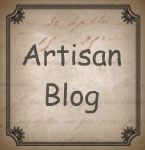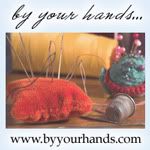We have a guest blogger today! Rhonda of Katty Whompus Primitives. Rhonda is stepping in and graciously
Shedding Light on Product Photography
By Rhonda Bruce
itsakattywhompuslife.blogspot.com
Let me begin by saying, I am by no means an expert photographer. Much of what I’ve learned, I’ve learned through trial and error. And sometimes my photos are still not as good as I’d like them to be, but they’re improving. I hope what I’ve learned along the way will help some of you.
When I first started selling on Etsy, my photos were not very good at all. Here’s an example:
My camera is a Sony Cyber-shot, 7.2 Mega pixels. This photo was taken in my dark living room, against a dark background, with a light source (table lamp) to the lower left, using the flash on my camera. There’s not much that’s right with this photo. It’s not centered. The angle is strange. It’s cluttered. It’s grainy. It’s dark. And let’s face it; it’s just not esthetically pleasing. I can hardly believe I sold anything with photos like this.
Here are a few more examples of “off” photos:
As you can see from my examples, lighting is everything. The items are adorable…but the photos are terrible. These were taken on my kitchen table, camera flash on, using 2 “work lights” with halogen bulbs. Not only are these lights hot to work under, but as you can see this kind of bulb gives an unattractive, artificial yellow cast. Do you notice the yellow tinge and blurry look these photos have? Notice the glare around the cow’s face created by my flash? These are better that the apron photo, but not by much.
There are a number of easy and low cost things that you can do to improve the overall look of your photographs. I hope these tips will help you avoid my mistakes and start you on your way to better product photography.
First let’s talk about lighting. Low light causes blurry pictures, period. There’s no way around that, and no substitute for good lighting.
Your best bet is always the natural light provided by the great outdoors. This is hands down your best choice during good weather or if you live where the climate is mild year round (lucky you!). The best exposure will be under the shade of a porch or tree on a bright sunny day. Photos taken in direct sunlight will sometimes look harsh and washed out. If I am photographing small items I prepare a tray to carry things outside on. This makes it easy to arrange small items on different backgrounds without too much trouble. I use the largest squares of scrapbooking paper I can find, and I try different colors and patterns to see what photographs best with each item. Plain colors work great, as do small or undefined patterns that are not too busy. You can also use fabric backgrounds, just be sure they are clean and wrinkle free. Heavy fabrics work best to eliminate light spots and shadows in your photos. Other choices for backgrounds might include a set of old shutters or section of solid fence. Almost anything that you find pleasing can be used as a background for your photos- just use your imagination! You’ll want to choose backgrounds that either make your item pop or coordinate with your item for a softer look. Keep in mind that light backgrounds reflect light, while dark backgrounds absorb light. So the darker your background, the more light you’ll need and vice versa.
Notice how these little houses POP against the blue background?
And in this photo the soft background paper compliments the color of the vintage lace?
If you are unable to go outdoors to photograph your product, there are several options you might consider. One is to take photos near a sunny window in your house or apartment. You will need to observe the natural light to see what time of day works best in the location you choose. I have a large kitchen window that gets southern exposure, so morning is best for taking photos in that location. Avoid shadows, glare and dappled sunlight, all of which will negatively affect the quality of your photos.
Because I live where the weather is often inclement, and because other duties typically need my attention in the mornings, I had to come up with a way to take photos at any time of the day, and in any weather.
And because I’m on a limited budget, I also needed something that wasn’t too expensive. This is what I came up with:
I used a large plastic bin, turned on its side, to create a make-shift light box. (We might also call this a “make-do” in the primitive world J) You’ll want to choose a translucent bin large enough to accommodate your product. The frosted plastic creates filtered light, allowing just enough soft light to pass through its sides. Using double sided tape, affix your background paper inside the light box. Starting at the front edge lay your paper up and over the bottom/back corner and work the paper up the back of the box. Do not crease or fold the paper, thus giving your background a seamless look. If you want a product, such as ornaments or jewelry, to hang in the box, you can simply drill a small hole in the “roof” (with is actually the side) of the box and hang the item in front of your paper background using clear thread.
In addition to a bin, you will need 3 or 4 clip-on lights outfitted with daylight bulbs to give your photos great natural color. I used inexpensive, clip on, aluminum reflector lights with Bright Effects, 60Watt Daylight bulbs (The Bright Effects bulbs are available at Lowe’s for $3.98 each. Ott also makes a great twist in Daylight bulb, but they are a little pricier at about $15 each). These lights should be placed at both sides, on top, and at the front of your light box. You will need to experiment, moving them around to see what gives you the best light placement with little or no shadow. In some instances, like when an item is too large for the box or I just want a different look, I take photos right on my wood countertop. I use the lights, arranged in the same way, adjusting them to focus light on my product. Here’s how that looks:

I’m fortunate to have a place to stow everything just beneath the spot where I take photos. I keep my lights, along with a power strip, tucked in the bin (aka light box) and ready to go. During a shoot, I find it easier to plug everything into a light strip so that I can turn all four lights on/off at the same time. Keeping my supplies in one place also means it’s not a chore to set up a photo shoot. If you’re anything like me, you’ll put off a job that requires a major effort. So if you can, I suggest keeping all your photography supplies in one place.
In all instances, I use my camera without the flash. In my experience, using the flash seems to make photos look garish and unappealing. I find it very difficult to get natural color using flash photography.
A tip for getting great, clear close ups is to use your macro setting. The macro setting allows you to focus on the details of your item. Macro is used to take crisp, clear, extreme close ups. On your camera the icon for the macro setting will look like a little flower. Most digital cameras have a macro setting, even the more inexpensive models. Consult your camera’s manual to find out if your camera has a macro setting, and how to turn it on. And while you’re at it READ THE REST OF THE MANUAL. J Understanding how your camera’s settings work will benefit you greatly.
Look at the detail in these photos taken using the macro setting.
The effective use of props and mannequins can be the difference between an average photo and a great photo. Clothing and jewelry always look best when displayed on a proper form, or at the very least artfully arranged. There seem to be mixed feelings about using live models to display these types of items, so you’ll have to decide for yourself how you feel about doing so. In any case live models should always look neat and clean. The chipped nail polish or blemishes that are part of everyday life should not make an appearance in product photos. I can’t tell you how many times I’ve seen this and how unappealing it makes a product appear.
A few more thoughts about choosing backgrounds… I think the kind of background you choose to showcase your product is a personal choice. The background sets the mood for your product and also the overall look of your shop. Some people swear by a solid white background…and no doubt about it, white makes an item pop. And white will always look clean and professional. But personally, I think white is a little…well, boring. I know that most of us who “do” primitives, like to create nifty vignettes that show off our goods in the kind of setting they will be displayed in. Our particular challenge is perhaps not to use TOO many props, which can confuse the customer about what they are purchasing, or even looking at. And avoid using photos that are so dark that they don’t show our product to its best advantage. Just make sure that whatever you choose for your background, it compliments your product without overwhelming it.
Since you’ve read all the way to the end, I’ll tell you my biggest photography secret. I sometimes take 30-50 photos of the same item, just to get 5 good shots for Etsy. Items should be photographed from every angle, back front, inside & out. In the case of vintage items, you should show any wear or damage in at least one photo. Remember to center the item you are photographing, especially for use on Etsy, which crops photos from the center. When photographing my items I intentionally change backgrounds, props, and even tweak the lighting a bit to give me several looks to choose from. I take close ups, photograph from weird angles, and sometimes just take a picture of a tiny corner of an item. It’s not a quick process, but surprisingly, one I’ve found that I enjoy a great deal.
After the shoot, I load my photos onto my computer and view them in “slide show” mode. This view fills my entire computer screen, which helps me see the details of each photo and imagine how it will look to a potential customer. Next, I weed out photos one by one using a side by side comparison. I try to choose photos that accurately represent my items in an interesting way. When I’ve done a good job photographing, my photos need very little editing. Generally, I only have to use Photoshop to crop and resize photos, which saves valuable time. If you aren’t lucky enough to have Photoshop on your computer, there are a number of great free photo editing programs online for you to choose from, such as Picasa, and Picnik. A Google search will help you find what you need.
Remember, even though a picture is worth a thousand words…your description is important too. Please include important details in your listing that tell us what we are looking at. Great photos and great descriptions should go hand in hand. And using all the tools in your toolbox just might bring you more sales. And isn’t that what we’re after?
I hope you’ve found this tutorial helpful…please feel free to email me at the address listed on my blog page with further questions. ~Rhonda~
Thank you Rhonda for sharing this very informative tutorial with us!!! Stop by and visit with Rhonda. We know she would love to hear from you and see some photos using her techniques.



























































































.JPG)


















11 comments:
Very good and thorough tutorial. Really helpful. Thanks Ronda:)
Thanks so much Rhonda! Great tips!
Indeed, photos are everything! Thank you for all your tips.
Dawn from The Pip Berry Tree
Wow...thanks so much for all the useful hints and tips, Rhonda. Great tutorial!
Debbie
Great tutorial! THanks for the great info!!!!
Carmen and the Primcats
Wonderful tutorial on photographing our items.
I try to use extra light, but not always possible.
I used to have a sony, really miss using it for macro and night shots. I wanted a camera with interchangeable lenses, for nature shots, so not as great indoors.
Debbie
Great tips in this tutorial! the thing I hate the most and now I think I might be able to do it with less bad words involved!
Thank you Ronda!
Barb
So glad to see that everyone is finding this helpful! :)
Rhonda
THANKS Rhonda! Great and informative tutorial!
Rhonda, awesome tutorial! That is very helpful for taking pics. I bought the light bulbs & clip-on lights yesterday, now I just need paper & bin. My husband thought I was crazy buying all these lights! LOL :) Laura Sweet
Amazing tutorial. Extremely informative and detailed. Fabulous picture of the photo shoot set up. That's sometimes how my kitchen looks. Paper taped up, lights here and there, etc.. I love the idea of directing the lights thru the plastic for softness - that I haven't tried yet, but I will. Thanks a gazillion!!!
Post a Comment